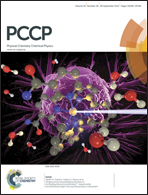Structural skeleton of preferentially interpenetrated clusters and correlation with shear localization in Mg–Cu–Ni ternary metallic glasses
Abstract
Inherent hierarchical structure and its effect on shear localization were clarified for ternary Mg–Cu–Ni metallic glasses via molecular dynamics studies based on a newly constructed n-body potential for the system. Assisted by a proposed index to detect the medium-range correlation heterogeneity, it was found that the Cu/Ni-centered icosahedra and specific Mg-centered clusters exhibit a strong preference to interconnect, leading to the formation, over an extended scale, of a percolated network that serves as structural skeleton in the glassy matrix. In constituting the skeleton network, the clusters mainly integrate in an interpenetrating mode, while the noninterpenetrating linkages provide additional reinforcements, jointly consolidating the structural and energetic stability of the skeleton. Furthermore, by monitoring the structural evolution upon compressive deformation, it was revealed that the gradual collapse of the skeleton network is intimately correlated to the mechanical response of metallic glasses and acts as a structural signature of the initiation and propagation of shear bands.


 Please wait while we load your content...
Please wait while we load your content...